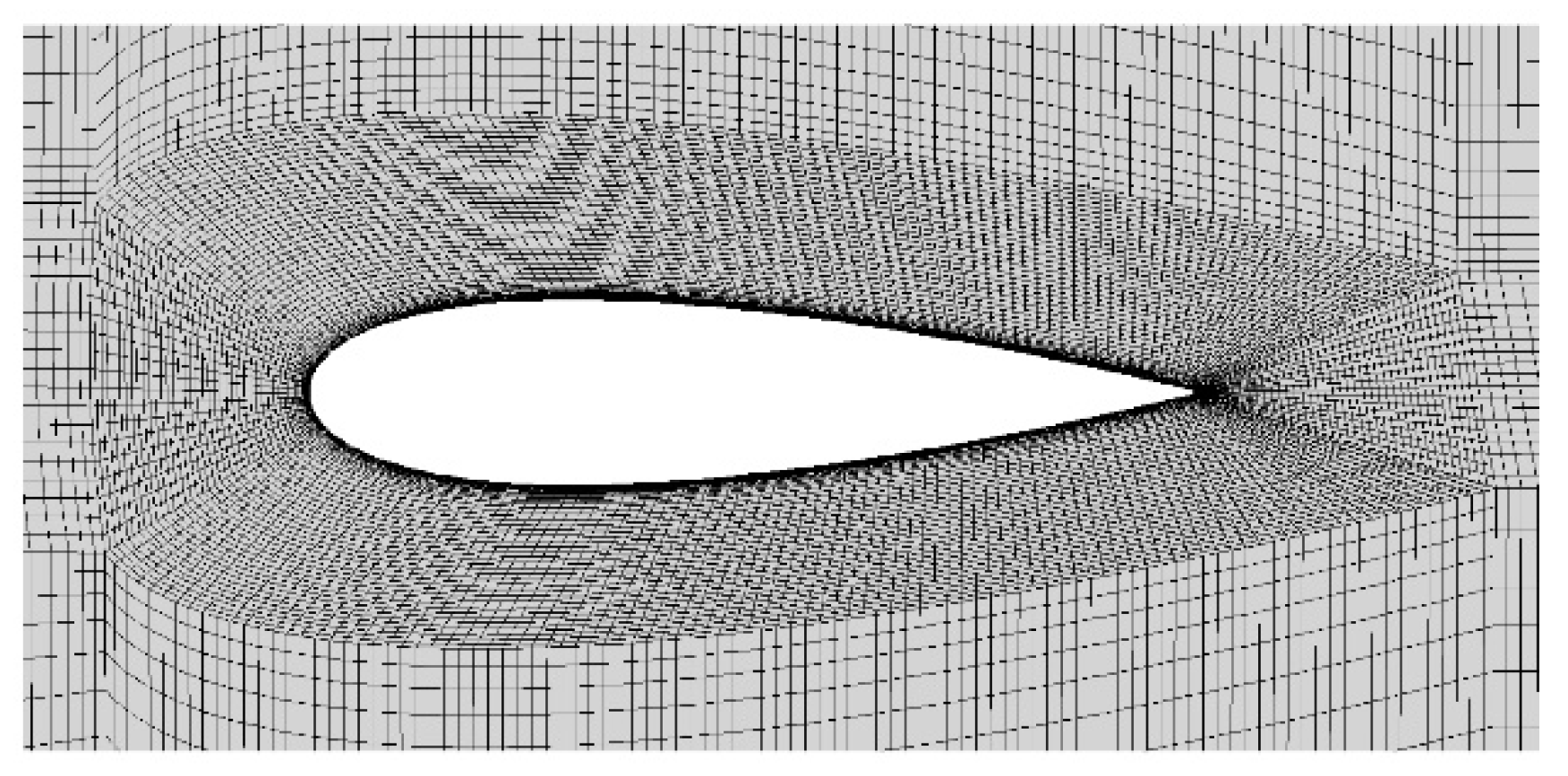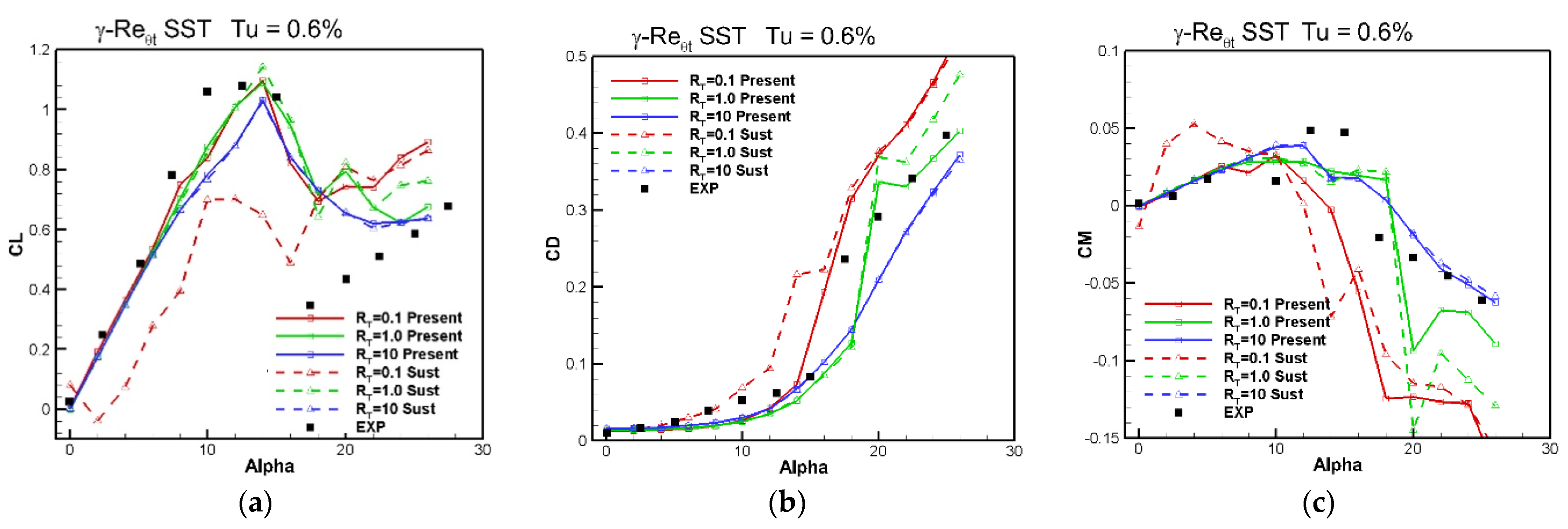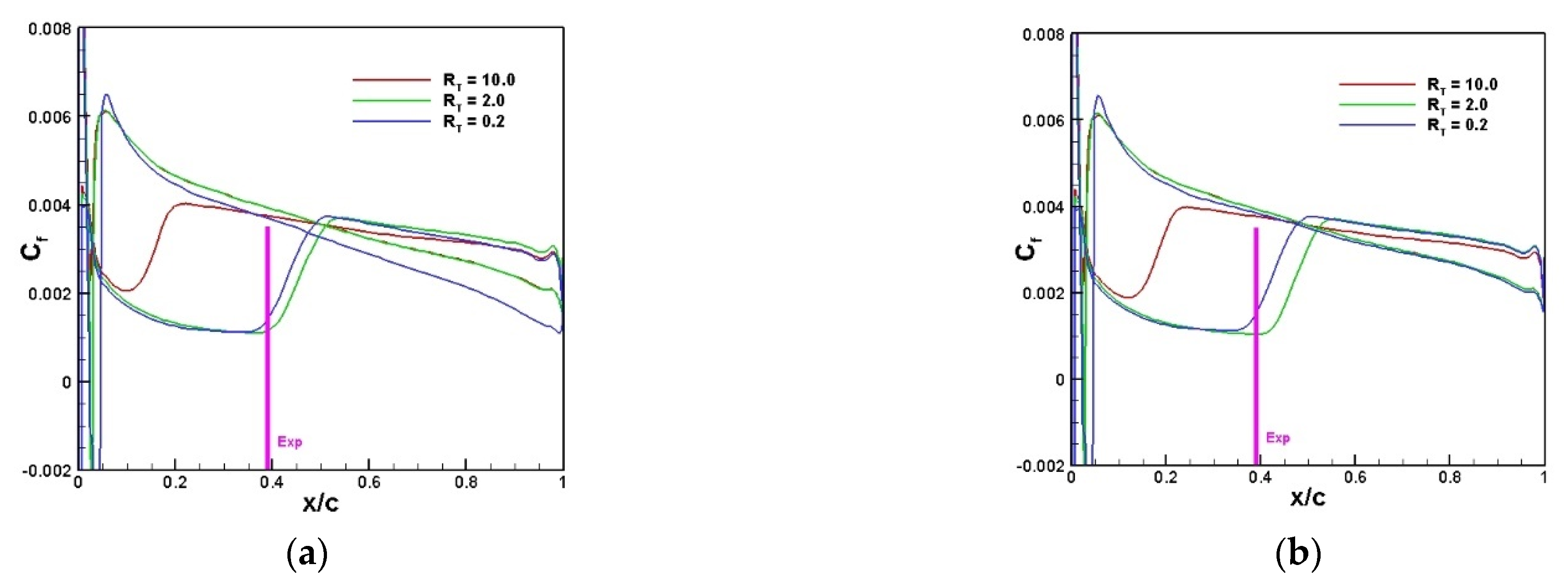The Application of the γ-Reθt Transition Model Using Sustaining Turbulence
Abstract
:1. Introduction
2. Langtry and Menter γ-Reθt SST Model
2.1. Standard SST vs. SST-2003
2.2. γ-Reθt SST Model and Its Helicity-Based CF-Extension
2.3. γ-Reθt SST Model with Sustaining Turbulence
3. Results and Discussion
3.1. NACA0021 Airfoil
3.2. ONERA-D Infinite Swept Wing
3.3. DLR 6:1 Prolate Spheroid
4. Conclusions
Author Contributions
Funding
Institutional Review Board Statement
Informed Consent Statement
Data Availability Statement
Conflicts of Interest
References
- Langtry, R.B.; Menter, F.R. Correlation-based transition modeling for unstructured parallelized computational fluid dynamics codes. AIAA J. 2009, 47, 2894–2906. [Google Scholar] [CrossRef]
- Suluksna, K.; Juntasaro, E. Assessment of intermitte ncy transport equations for modeling transition in boundary layers subjected to freestream turbulence. Int. J. Heat Fluid Flow 2007, 29, 48–61. [Google Scholar] [CrossRef]
- Rumsey, C.L.; Lee-Rausch, E.M. NASA trapezoidal wing computations including transition and advanced turbulence modeling. J. Aircr. 2014, 52, 496–509. [Google Scholar] [CrossRef]
- Seyfert, C.; Krumbein, A. Evaluation of a correlation-based transition model and comparison with the eN method. J. Aircr. 2012, 49, 1765–1773. [Google Scholar] [CrossRef]
- Halila, G.L.O.; Antunes, A.P.; Silva, R.G.; Azevedo, J.L.F. Effects of boundary layer transition on the aerodynamic analysis of high-lift systems. Aerosp. Sci. Technol. 2019, 90, 233–245. [Google Scholar] [CrossRef]
- Grabe, C.; Krumbein, A. Extension of the γ-Reθt model for prediction of crossflow transition. In Proceedings of the 52nd Aerospace Science Meeting, AIAA Paper 2014-1269. National Harbor, MD, USA, 13–17 January 2014. [Google Scholar]
- Choi, J.H.; Kwon, O.J. Enhancement of a correlation-based transition turbulence model for simulating crossflow instability. AIAA J. 2015, 53, 3063–3072. [Google Scholar] [CrossRef]
- Xu, J.K.; Bai, J.Q.; Qiao, L.; Zhang, Y. Correlation-based transition transport modeling for simulating crossflow instabilities. J. Appl. Fluid Mech. 2016, 9, 2435–2442. [Google Scholar] [CrossRef]
- Arnal, D.; Habiballah, M.; Coustols, E. Laminar instability theory and transition criteria in two and three-dimensional flow. Rech. Aerosp. 1984, 2, 45–63. [Google Scholar]
- Müller, C.; Herbst, F. Modeling of crossflow induced transition based on local variables. In Proceedings of the 6th European Conference on Computational Fluid Dynamics (ECFD VI), Barcelona, Spain, 20–25 July 2014. [Google Scholar]
- Langtry, R.B.; Sengupta, K.; Yeh, D.T.; Dorgan, A.J. Extending the γ-Reθt local correlation based transition model for crossflow effects. In Proceedings of the 45th AIAA Fluid Dynamics Conference, Dallas, TX, USA, 22–26 June 2015. AIAA paper 2015–2474. [Google Scholar]
- Medida, S.; Baeder, J. A new crossflow transition onset criterion for RANS turbulence models. In Proceedings of the 21st AIAA Computational Fluid Dynamics Conference, AIAA paper 2013–3081. San Diego, CA, USA, 24–27 June 2013. [Google Scholar]
- Grabe, C.; Nie, S.Y.; Krumbein, A. Transport modeling for the prediction of crossflow transition. AIAA J. 2018, 56, 3167–3178. [Google Scholar] [CrossRef]
- Langtry, R. A Correlation-Based Transition Model Using Local Variables for Unstructured Parallelized CFD Codes. Ph.D. Thesis, Univ. of Stuttgart, Stuttgart, Germany, 2006. [Google Scholar]
- Savill, A.M. Some Recent Progress in the Turbulence Modelling of By-Pass Transition, Near-Wall Turbulent Flows; So, R.M.C., Speziale, C.G., Launder, B.E., Eds.; Elsevier: New York, NY, USA, 1993; p. 829. [Google Scholar]
- Bode, C.; Aufderheide, T.; Friedrichs, J.; Kožulović, D. Improved Turbulence and Transition Prediction for Turbomachinery Flows. In Proceedings of the ASME 2014 International Mechanical Engineering Congress and Exposition, Montreal, QC, Canada, 14–20 November 2014. [Google Scholar]
- Spalart, P.; Rumsey, C. Effective inflow conditions for turbulence models in aero-dynamic flows. AIAA J. 2007, 45, 2544–2553. [Google Scholar] [CrossRef]
- Turbulence Modeling Resource. Available online: http://turbmodels.larc.nasa.gov (accessed on 5 July 2022).
- Menter, F.R. Two-equation eddy-viscosity turbulence models for engineering applications. AIAA J. 1994, 32, 1598–1605. [Google Scholar] [CrossRef] [Green Version]
- Menter, F.R. Improved Two-Equation k-Omega Turbulence Models for Aerodynamic Flows. NASA-TM-103975, October 1992. Available online: https://ntrs.nasa.gov/citations/19930013620 (accessed on 3 March 2022).
- Menter, F.R.; Kuntz, M.; Langtry, R. Ten years of industrial experience with the SST turbulence model. In Turbulence, Heat and Mass Transfer, 4th ed.; Hanjalic, K., Nagano, Y., Tummers, M., Eds.; Begell House, Inc.: Danbury, CT, USA, 2003; pp. 625–632. [Google Scholar]
- Sorensen, N. Prediction of airfoil performance at high Reynolds numbers. In Proceedings of the EFMC 2014, Copenhagen, Denmark, 17–20 September 2014. [Google Scholar]
- Diakakis, K.; Papadakis, G.; Voutsinas, S.G. Assessment of transition modeling for high Reynolds flows. Aerosp. Sci. Technol. 2019, 85, 416–428. [Google Scholar] [CrossRef]
- Ströer, P.; Krimmelbein, N.; Krumbein, A.; Grabe, C. Stability-based transition transport modeling for unstructured computational fluid dynamics including convection effects. AIAA J. 2020, 58, 1506–1517. [Google Scholar] [CrossRef]
- Nie, S.Y.; Krimmelbein, N.; Krumbein, A.; Grabe, C. Coupling of a Reynolds stress model with the γ-Reθt transition model. AIAA J. 2018, 56, 146–157. [Google Scholar] [CrossRef]
- Nie, S.Y.; Krimmelbein, N.; Krumbein, A.; Grabe, C. Extension of a Reynolds-stress-based transition transport model for crossflow transition. J. Aircr. 2018, 55, 1641–1654. [Google Scholar] [CrossRef]
- Endo, S.; Sujisakulvong, T.; Kuya, Y.; Ariki, T.; Sawada, K. Laminar-turbulent transition modeling with a Reynolds stress model for anisotropic flow characteristics. In Proceedings of the AIAA Scitech 2020 Forum, AIAA paper 2020-1311. Orlando, FL, USA, 6–10 January 2020. [Google Scholar]
- Zhou, L.; Gao, Z.H.; Du, Y.M. Flow-dependent DDES/γ-Reθt coupling model for the simulation of separated transitional flow. Aerosp. Sci. Technol. 2019, 87, 389–403. [Google Scholar] [CrossRef]
- Nie, S.Y.; Wang, Y.; Liu, Z.Q.; Jin, P.; Jiao, J. Numerical investigation and discussion on CHN-TI benchmark model using Spalart-Allmaras model and SSG/LRR-ω model. Acta Aerodyn. Sin. 2019, 37, 310–319. (In Chinese) [Google Scholar]
- Swalwel, K.E. The Effect of Turbulence on Stall of Horizontal Axis Wind Turbines. Ph.D. Thesis, Monash University, Victoria, Australia, 2005. [Google Scholar]
- Menter, F.R.; Smirnov, P.E.; Liu, T.; Avancha, R. A one-equation local correlation-based transition model. Flow Turbul. Combust. 2015, 95, 583–619. [Google Scholar] [CrossRef]
- Schmitt, V.; Manie, F. Écoulement subsoniques et transsoniques sur une aile a flèche variable. Rech. Aérospatiale 1979, 4, 219–237. [Google Scholar]
- Kreplin, H.-P.; Vollmers, H.; Meier, H.U. Wall shear stress measurements on an inclined prolate spheroid in the DFVLR 3 m × 3 m low speed wind tunnel. Data Rep. DFVLR IB 1985, 222–284. [Google Scholar]
- Krimmelbein, N.; Krumbein, A.; Grabe, C. Validation of transition modeling techniques for a simplified fuselage configuration. In Proceedings of the 2018 AIAA Aerospace Sciences Meeting, AIAA paper 2018-0030. Kissimmee, FL, USA, 8–12 January 2018. [Google Scholar]
- Jeong, J.; Hussain, F. On the identification of a vortex. J. Fluid Mech. 1995, 285, 69–94. [Google Scholar] [CrossRef]














| Turbulence/Transition Model | SST | SST2003 | γ-Reθt SST FD | γ-Reθt SST-2003 FD | γ-Reθt SST Sust | γ-Reθt SST Present | γ-Reθt SST-2003 Sust | γ-Reθt SST-2003 Present |
|---|---|---|---|---|---|---|---|---|
| Time (s) | 2188.6 | 2237.9 | 8600.5 | 7775.2 | 3746.9 | 3873.7 | 3620.9 | 3863.6 |
| Time increment | 1 | 1.02 | 3.93 | 3.55 | 1.71 | 1.77 | 1.65 | 1.77 |
| RT,FS | 0.2 | 2.0 | 10 | |
|---|---|---|---|---|
| Transition Models | ||||
| γ-Reθt SST | Sust [4] | 0.430 | 0.451 | 0.155 |
| γ-Reθt SST-2003 | Sust [4] | 0.440 | 0.442 | 0.442 |
| γ-Reθt SST | Present | 0.425 | 0.468 | 0.185 |
| γ-Reθt SST-2003 | Present | 0.486 | 0.485 | 0.481 |
| Exp | 0.39 | |||
| RT,FS | 0.1 | 1.0 | 5.0 | 10.0 | |
|---|---|---|---|---|---|
| Transition Models | |||||
| γ-Reθt SST-2003 | free decay | 0.0046 | Not computed | ||
| γ-Reθt SST | Present | 0.0071 | 0.0056 | 0.0065 | 0.0065 |
| γ-Reθt SST-2003 | Present | 0.0069 | 0.0057 | 0.0064 | 0.0064 |
Publisher’s Note: MDPI stays neutral with regard to jurisdictional claims in published maps and institutional affiliations. |
© 2022 by the authors. Licensee MDPI, Basel, Switzerland. This article is an open access article distributed under the terms and conditions of the Creative Commons Attribution (CC BY) license (https://creativecommons.org/licenses/by/4.0/).
Share and Cite
Zhang, M.; Nie, S.; Meng, X.; Zuo, Y. The Application of the γ-Reθt Transition Model Using Sustaining Turbulence. Energies 2022, 15, 6491. https://doi.org/10.3390/en15176491
Zhang M, Nie S, Meng X, Zuo Y. The Application of the γ-Reθt Transition Model Using Sustaining Turbulence. Energies. 2022; 15(17):6491. https://doi.org/10.3390/en15176491
Chicago/Turabian StyleZhang, Meihong, Shengyang Nie, Xiaoxuan Meng, and Yingtao Zuo. 2022. "The Application of the γ-Reθt Transition Model Using Sustaining Turbulence" Energies 15, no. 17: 6491. https://doi.org/10.3390/en15176491
APA StyleZhang, M., Nie, S., Meng, X., & Zuo, Y. (2022). The Application of the γ-Reθt Transition Model Using Sustaining Turbulence. Energies, 15(17), 6491. https://doi.org/10.3390/en15176491





